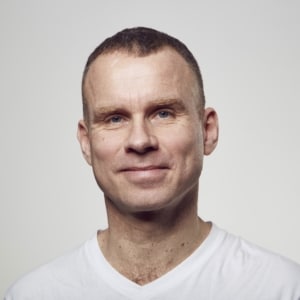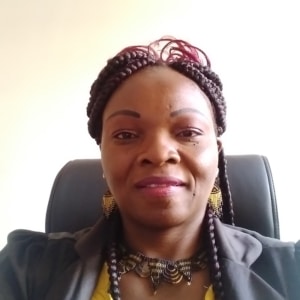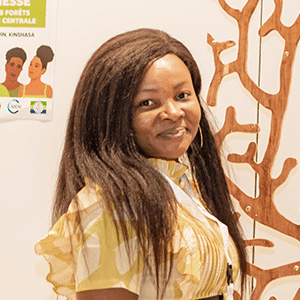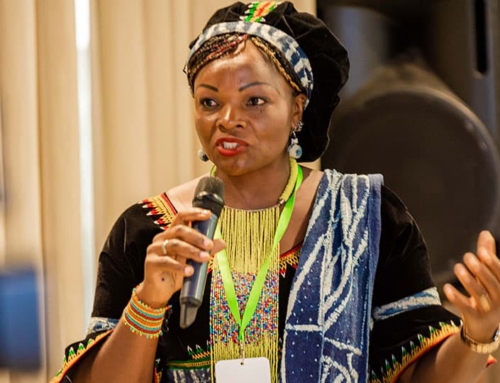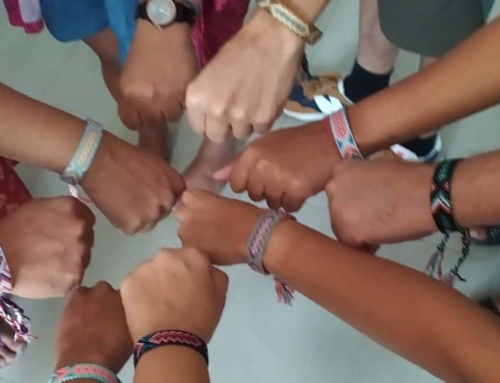In the second part of the series, we continue our interview with Julie Gagoe Tchoko and Merline Touko Tchoko, two sisters from Cameroon, who have been working with Synchronicity Earth as affiliates in our Congo Basin Programme since 2021.
In the first part of our discussion with Julie and Merline, we learnt about the personal experiences that drew them into conservation in the Congo Basin, and the complexities of working in this environment.
Here, we take a deeper look at the context of their affiliate work and conservation approaches in the region, exploring the challenges local organisations face, the successes of community-led action, and what funders can do better.
Q: What does it mean to be an ‘affiliate’ with Synchronicity Earth?
Merline: Our role is to work with and support the organisations that Synchronicity Earth funds in the region. We are present on the ground with those partners, helping to resolve problems, identify capacity needs, and present their results effectively.
Affiliates often live in the same region as partners, so they are familiar with the challenges. They find solutions based on their knowledge and experience, which helps Synchronicity Earth to fund and support them.
Julie: Affiliates also motivate the partners and strengthen their capacity.
“The approach brings flexibility and supports the sense of ‘being in this together’ that Synchronicity Earth brings to its relationships with partners.”
Merline: Yes, this allows us to identify problems very quickly and to resolve them. For example, when I participated in the Mini-Congress in Kinshasa (organised for partners in the Democratic Republic of Congo (DRC) unable to get to the IUCN World Conservation Congress in Marseilles), I realised that many of our partners struggled to present their work effectively using software such as Microsoft Powerpoint.
I spoke to Sophie Grange-Chamfray, the Congo Basin Programme Lead at Synchronicity Earth, and with the partner organisations, and we decided to provide some training. Today, when the people who attended this training present their results, it is so much more dynamic, and easier to understand than before.
Q: What are some of the greatest challenges involved in protecting the Congo Basin?
Julie: It’s extraordinary how the Congo Basin has all these resources, and these diverse populations, yet so many of the people in the forest live in extreme poverty. I constantly ask myself how populations in such a rich environment – trees that are hundreds of years old, animals that you can’t see anywhere else, soil that is super rich in minerals and nutrients, hidden water sources… In a place with so many resources, how can the people be so poor?
Merline: Of course, there are the challenges that will be familiar – deforestation, poaching, corruption.
“But for me, the greatest challenge is how to reconcile the protection of this vast and precious forest ecosystem with the need to support the development and wellbeing of the people who live there.”
Julie: Absolutely! We need to conserve what’s there, but must also recognise the need for infrastructure. People need roads, schools, health facilities. It is vital to ensure that all of this is connected if we want to move towards the kind of conservation that the region needs.
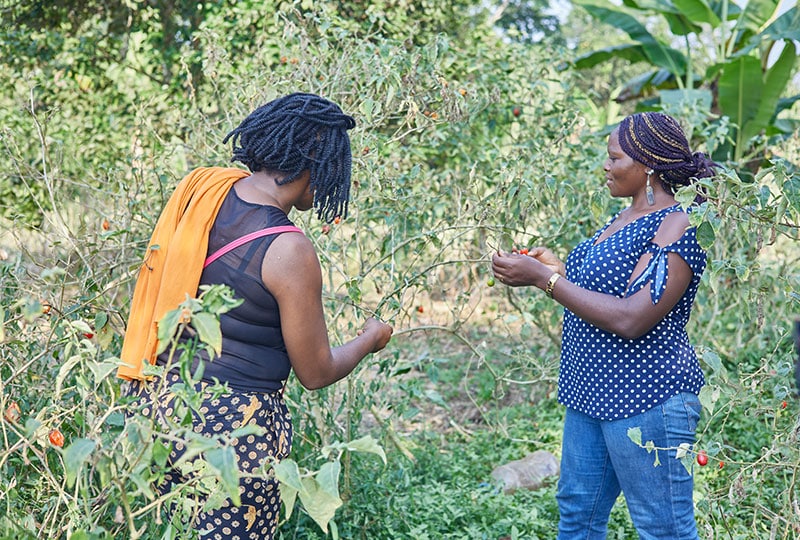
Merline (left) and Julie (right) visiting a community with our partner African Marine Mammal Conservation Organisation (AMMCO), who are working to make Central Africa’s coastal and aquatic environments safe for marine wildlife. © AMMCO
Q: Given that context, could you give us some examples of effective local conservation solutions that you are familiar with?
Merline: With the support of Synchronicity Earth, Femmes Solidaires (FESO) has managed to buy some land for their community. The women FESO works with grow crops and other plants on this community-owned land, sell their harvest, and share the profits between them.
Supported by FESO, they have learnt to use revenue from these community fields to develop other commercial activities, and then bulk buy things like notebooks for their children. So, these activities support their children’s education and improve their standard of living while helping to protect nature and species in the region’s forests. This income source means they no longer need to go into the forest to cut trees or kill animals. This is a perfect example of an effective local conservation solution.
Julie: Another good example is the organisation Green Development Advocates (GDA), based here in Cameroon. They defend the rights of local and Indigenous communities who are impacted by large-scale projects in the region (agro-industry, mining, dam building). With Synchronicity Earth’s support, GDA do brilliant work: they facilitate access to the benefits derived from this exploitation of their living environment and advocate against appropriation or land grabs.
Then if you look at the DRC, Dynamique des Groupes des Peuples Autochtones (DGPA) has had an impact at a national level with the vote on the law in favour of the creation of forest concessions for Indigenous and local communities.
This shows what small civil society organisations can achieve with long-term, flexible support.
Q: What are some of the challenges facing local conservation and civil society organisations in the Congo Basin?
Merline: Simply getting access to funds to support the initiatives that they want to lead. When they do secure a funder, the money often comes with the expectation of immediate results, even if that does not fit with a logical timeline for the type of work being done, the right time of year to grow a crop – beans or peanuts, for example. That can make it difficult for the partners.
“Funding also often comes with complicated, difficult conditions attached: only certain activities permitted, no support for anything outside the confines of a specific project, and these funds often fail to respect the needs of local communities. People end up doing activities according to the terms of the funding, but not because those activities are needed.”
Another challenge is staff turnover. The turnover rate of employees in smaller organisations is high, which makes it hard to build up an experienced staff team with sustained experience. If somebody has a guaranteed income, and knows it is safe for ten years, they feel stable. But when you can only see the next two or three years ahead, if a bigger non-governmental organisation (NGO) comes and offers you greater job security, you’ll leave.
Julie: It’s also very difficult for them to participate in a climate or biodiversity Conference of the Parties (COP), where all the big decisions are taken. Fortunately, Synchronicity Earth can make a difference in that area for these organisations. Knowing that you will have financial support to attend allows you to prepare better.
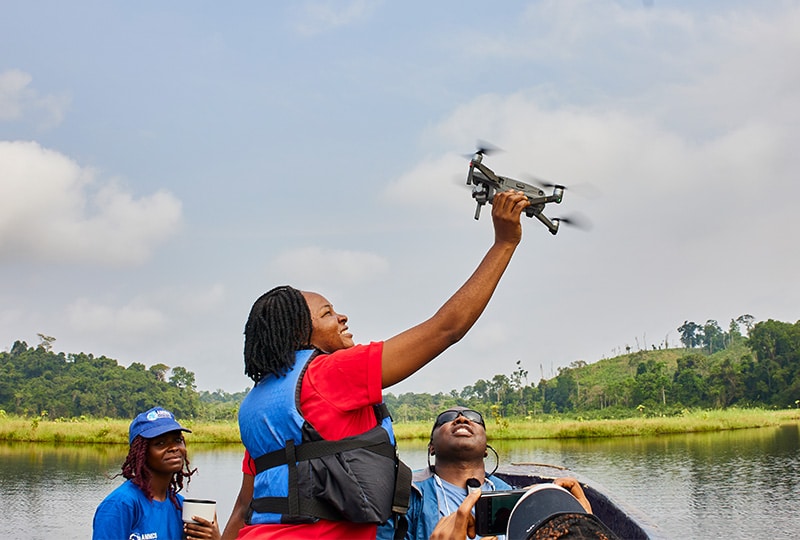
Merline on a field mission with AMMCO in Dizangué, Cameroon. © AMMCO
Q: What can environmental funders do better in the Congo Basin?
Merline: They should learn from Synchronicity Earth in terms of flexibility and ensure that their funding doesn’t come with restrictive conditions.
“Funders need to understand providing funding over longer timescales is vital to allow local organisations to better implement their conservation activities and deliver more measurable impacts.”
And we need to be better at the national level at understanding these large financing mechanisms focused on combatting climate change or nature loss. If you take REDD+ (a framework encouraging countries to reduce emissions through forest management methods) as an example, very few countries in the Congo Basin have benefitted from those funds. So, we need to establish training within different countries to help communities, local organisations, and civil society understand how to access these types of funding.

